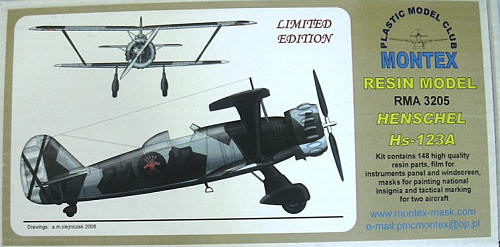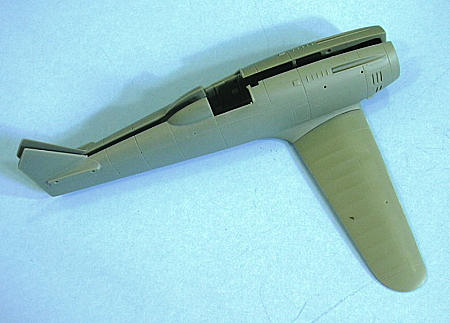
Montex 1/32 Hs-123A
| KIT #: | 32005 |
| PRICE: | $179.95 MSRP |
| MARKINGS: | Two options |
| REVIEWER: | Tom Cleaver |
| NOTES: | Full Resin kit |

| HISTORY |
The first designed-for-the-purpose dive bomber to see
production and combat, the Henschel Hs 123A-1 was a single-seat biplane dive
bomber and close-support attack aircraft that first saw combat with the German
Condor Legion in 1936 during the Spanish Civil War and the Chinese Air Force
against the Japanese Navy in 1938. Considered obsolete with the introduction of
the Ju-87 Stuka in 1937, the Hs-123 soldiered on through the Polish and French
campaigns and then the Eastern Front in the close-support role, where it was
more effective than more modern types.
Soon after Hitler came to power, Henschel - to that
point a locomotive manufacturer - decided to enter the aircraft industry.
Following his demonstration of the Curtiss Hawk, Ernst
Udet convinced Erhard Milch to order a dive-bomber for the new Luftwaffe.
Henschel’s reply - in competition to the Fieseler Fi-98
- was the Hs 123, designed to meet the 1933 requirements which specified a
single-seat biplane dive-bomber. Udet flew the Hs 123V1 prototype on its first
public demonstration on May 8, 1935. The first three Henschel prototypes,
powered by the 650 hp BMW 132A-3 engines, were tested at Rechlin in August 1936.
The Hs-123 did away with bracing wires and although they looked outdated, they
featured a fully-cantilever, all- metal construction, clean lines and excellent
maneuverability.
The performance of the Hs-123 V1 eliminated the more
conventional Fi-98. During testing, the Hs-123 proved capable of pulling out of
"near-vertical" dives.
Two prototypes crashed due to wing failures. The
Hs-123V-4 incorporated stronger cabane struts to cure this. After successful
tests, the Hs-123 was ordered into production with an 880 hp BMW 132Dc engine.
The Hs-123 was intended to replace the Heinkel He-50 as
well as be a "stop-gap" until the Junkers Ju-87 became available. Thus,
production was limited with no further development considered. Production ended
in October 1938 with 1000 aircraft.
A pre-production batch of Hs 123A-0s was produced in
1936 for service evaluation by the Luftwaffe,
and were followed by the slightly modified Hs 123A-1 series, which was equipped
with an armoured headrest and fairing, as well as removable main wheel spats and
a faired tailwheel. The weapon load of four SC 50 110 lb bombs were carried on
lower wing racks along with an additional SC250 550 lb (250 kg) bomb mounted on
a "crutch" beneath the fuselage, though this was usually replaced by a drop
tank. Two MG 17 machine guns (7.92 mm/0.312 in) were mounted in the nose
synchronized to fire through the propeller arc.
The Hs-123A-0 entered service with
StG 162 “Immelmann” in October
1936, serving until the unit re-equipped with the Ju-87 the following year. Five
Hs-123A-0 and A-1 aircraft were sent to Spain, where they proved highly
effective in the close-support role, proving capable of absorbing punishment and
getting home. The Spanish Nationalists were so impressed that they purchased the
five Condor Legion airplanes and eleven more.
Known as the “Angelito,” the Spanish Hs-123s served
until 1945, with one flown until the early 1950s. Twelve Hs-123s were exported
to China in 1938, where they saw extensive operation as dive bombers against
Japanese warships on the Yangtze River.
In 1938, the remaining Hs-123s were part of the
temporary Fliegergeschwader 100 during
the Munich Crisis. With the crisis over, the Hs-123s were transferred to
Lehrgeschwader 2 as II.(Schl)/LG2.
In the invasion of Poland, the 39 Hs-123s of LG 2 proved
particularly effective at close-support, where they were instrumental in
breaking up attempts by Polish cavalry to attack German units, due to the
“staccato” sound a pilot could induce in a dive by changing engine rpm.
Flown from primitive fields close to the front, ground
crews considered the Hs-123 reliable and easy to maintain. The leading pilot of
this unit was Hauptmann Adolf Galland,
who was at the time seen as a ground-attack expert due to his service with the
He-51 in this role in the Condor Legion.
After participating in the Battle of Kursk, SG 1 returned to the Crimea, where they finally gave up the aircraft they had flown through five campaigns after it had been declared obsolete. In July 1944, 7./SG 1 traded its last Hs-123s for Ju-87s, the type that had “replaced” them back in 1937.
| THE KIT |
 This Hs-123A-1 is the fifth full-resin kit from Montex
of Poland, following their Boomerang, Gloster Gamecock, Hawker Fury, and Fairey
Fawn.
As has been noted in revi
This Hs-123A-1 is the fifth full-resin kit from Montex
of Poland, following their Boomerang, Gloster Gamecock, Hawker Fury, and Fairey
Fawn.
As has been noted in revi ews of the previous kits, these are high-quality resin kits, with lots of great detail.
In test-fitting this kit, I can see that assembly is so
easy and straightforward that any modeler who has had any experience at all
assembling resin parts would have no difficulty building this kit out of the box
into a show-stopper.
ews of the previous kits, these are high-quality resin kits, with lots of great detail.
In test-fitting this kit, I can see that assembly is so
easy and straightforward that any modeler who has had any experience at all
assembling resin parts would have no difficulty building this kit out of the box
into a show-stopper.
The cockpit is fully detailed, lacking only seat belts
which are available from Eduard.
The BMW 132 engine is also fully-detailed, to the point
where it is almost a crime to enclose it in the beautiful three-part cowling.
The only place where the model will need seam-filling is
on the fuselage centerline.
Parts fit is entirely positive, so that it is impossible to get the dihedral of the upper wing wrong when assembling the two parts. All control surfaces are molded separately and can be posed dynamically.
Masks are provided to all the model to be built as a
Spanish Air Force “Angelito” in 1942,
or a Hs-123A-1 of 7./SG 1 on the
Eastern Front in 1942.
| CONCLUSIONS |
I have built the Airfix Hs-123 in 1/72 scale, and
several ESCI Hs-123s in 1/48 scale, including two of the upgraded kits from
AMTech, and can say that this is easily the best kit of this airplane produced
by anyone in any scale.
It is easy to assemble, even with all the small detail
parts, with no “wrestling” required.
If you like the Hs-123, or you just want to build a
really excellent model that will allow your talents to shine in the final
product, this kit is well worth its price.
Review kit courtesy of Montex.
November 2008
If you would like your product reviewed fairly and quickly, please contact me or see other details in the Note to Contributors.